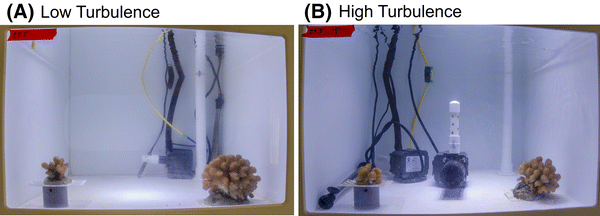Although coral reefs have been the subject of ecological studies for nearly a century, the role that environmental conditions play in coral development is still a partial mystery. LTER researchers at Mo’orea Coral Reef have been exploring coral-environmental interactions in an effort to better understand coral growth.
The team recently investigated how two key abiotic factors known to impact coral growth—the turbulent flow of seawater over the coral’s surface, and water temperature—interact to affect the metabolic processes of hard coral species. They are finding, to their surprise, that the responses of large and small colonies to the these two factors differ.

The experimental set-up: Low-flow tank on the left, high-flow on the right.
Credit: Edmunds et al. 2018
The Mo’orea ecologists set up experiments in tanks simulating a range of turbulent flow regimes and seawater temperature combinations that naturally occur on surrounding reefs. They maintained 12 small and 12 large colonies of the hard coral Pocillopora verrucosa, collected from local Moorea reefs, in various combinations of flow rate and temperature. After fourteen days, they quantified growth using calcification and colony size.
Previous studies have suggested that the effects of environmental conditions on small colonies can be used to estimate the responses of larger colonies, but the Mo’orea researchers did not find evidence to support this theory. They used the small corals’ metabolic responses to experimental conditions to estimate the response of large colonies to those same conditions on an allometric scale. When they measured the actual response of large corals, they found that they had overestimated growth.
The researchers provide a series of potential physiological explanations as to why this discrepancy occurs. For example, ammonium, which is important for coral growth, may dissipate more quickly from small corals than from the crevices of convoluted large corals. Regardless of what biological processes are behind these results, using estimates of calcification rates in small coral to approximate rates in larger coral may lead to misleading conclusions about scaling. Understanding how flow and temperature affect coral growth could lead to a better understanding of coral distribution and future reef conditions, but to realize this potential, it is necessary to account for colony size as an important variable as well.
-Amanda Kelley
Source: Edmunds, Peter J., and Scott C. Burgess. Colony size and turbulent flow speed modulate the calcification response of the coral Pocillopora verrucosa to temperature. Marine Biology (2018) 165.1: 13. https://doi.org/10.1007/s00227-017-3257-z.
Related data: Edmunds P. 2017. MCR LTER: Coral Reef: Coral size, temperature and turbulence data in support of Edmunds and Burgess MarBio 2017. Environmental Data Initiative. http://dx.doi.org/10.6073/pasta/d583e9ea5529c11cbc2c2884fd77ae14.









